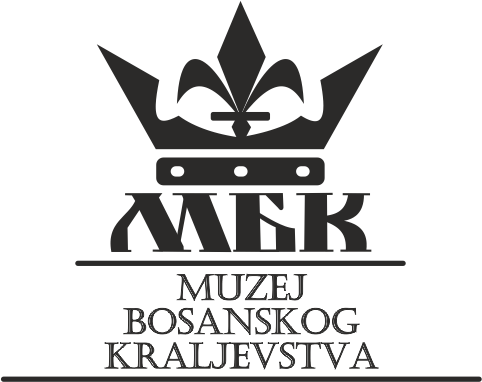The “Grčka glavica” necropolis in the village of Biskup near Glavatičevo is 30 kilometers southeast of Konjic. The area was part of the medieval county of Kom. In this area, there remains of a church and a stećak necropolis. The necropolis has a total of 172 stećak tombstones, and a large number of graves without stećak tombstones were recorded. The largest number of stećak tombstones are in the form of crates and slabs, and there is only one gable in the necropolis. There is a small number of stećak tombstones that are decorated. The represented relief motifs on this necropolis are a frieze of bent lines with trefoils, with the third leaf elongated and bent, as well as a frieze of oblique parallel lines, arcades. The monument is of high quality. The orientation of a stećak is northwest-southeast. A portion of the stećak tombstones is located within the church, whereas the majority are found around the church. It is a Romanesque church with a semicircular apse dating back to the 12th or 13th century. Therefore, the church was not built as a mausoleum for a single family, but rather served as their necropolis from the end of the 13th century. This is supported by the fact that the stećak tombstones around the church are of a younger date than those inside the church walls. Within the foundations of the church lie the graves of the famous Bosnian aristocratic kindred of Sanković. Due to this fact, there is a question concerning the religious affiliation of the Sanković rulers.
On one tall chest without ornaments, there is an epitaph in which the name of Goisava, wife of duke Radič Sanković, daughter of Juraj Balšić from Zeta, is mentioned. She was buried at the end of 1398. A Ragusan dinar, 14 coins from Venice, Verona and Mantua dating from the end of the 13th and beginning of the 14th century, and a silk ribbon were discovered in her grave. Various valuable objects were also found in other graves inside the church: a gold brocade dress and cap, brocade ribbons, silk dresses, a glass goblet made in Venice at the end of the 14th century, over a hundred silver buttons, and an earthen pot. Besides Goisava’s, several other stećak tombstones attract attention. Numerous valuable objects were found beneath a decorated stećak weighing about eight tons, which was placed next to the apse of the church. Among other things, it included a heart-shaped brocade coat of arms. As it dates from the 13th century, it is presumed to be the grave of an older ancestor of the Sankovićs. A stone sarcophagus was found in the grave located in the middle of the church, which is rare among graves under stećak tombstones. It is likely that the deceased was moved from another grave to this one. The grave contained a skeleton with a deep cut on the right leg caused by a sword. Some historians believe that this could be the grave of the Bosnian nobleman kaznac Sanko Miltenović, whose body was subsequently transferred to his heritage (baština) possessions after his death. This thesis does not appear to be supported by any substantial evidence.
The Sankovićs belonged to a circle of prominent Bosnian aristocratic kindred that can be traced back four generations. The oldest known member was Dražen Bogopenec, who was mentioned in 1306. This family’s influence ended with the death of its most prominent representative, Radič Sanković, in 1404. At the end of the 14th century, the Sanković kindred owned the area from the upper reaches of the Neretva and Nevesinje towards the sea, to Popovo polje, Primorje and Slano to Konavle. They acquired political influence thanks to their close proximity to the border. A more significant role of the lineage was recorded in the thirties and forties of the 14th century during the time of župan (prefect) Milten Draživovjević, who was in the service of the Serbian emperor Dušan, and then the Bosnian ban Stjepan II Kotromanić. A prominent representative of the lineage was the kaznac Sanko Miltenović, who also received citizenship from the neighboring Ragusan authorities. Sanko’s sons Bjeljak and Radič, who led the lineage at the end of the 14th and at the beginning of the 15th century, are the last descendants of this lineage. In this period, the Sanković family achieved exceptional power and influence. They made the famous failed attempt to sell Konavale to the Ragusans in 1391, which marked the beginning of the end of this lineage. The center of their possessions was located near Konjic in Zaborani near the necropolis in Biskup.
Sources and literature:
- Bešlagić Šefik, Stećci – kultura i umjetnost, Veselin Masleša, Sarajevo 1982, 52, 116, 250, 325, 511.
- Bešlagić Šefik, Stećci. Kataloško-topografski pregled, Veselin Masleša, Sarajevo 1971, 334.
- Bešlagić Šefik, Leksikon stećaka, Svjetlost, Sarajevo 2004, 19.
- Lovrenović Dubravko, Stećci. Bosansko i humsko mramorje srednjeg vijeka, Rabic, Sarajevo 2009, 160-164.
- Mijušković Jovanka, “Humska vlasteoska porodica Sankovići”, Istorijski časopis, no. XI, Organ istorijskog instituta SANU, Beograd 1960, 17-54.
- Pavao Anđelić, “Grčka glavica”, in: Arheološki leksikon Bosne i Hercegovine, vol. III, ed. Borivoj Čović, Arheološka nalazišta regija 14-25, Zemaljski muzej Bosne i Hercegovine, Sarajevo 1988, 215.
- Vego, Marko, “Nadgrobni spomenici porodice Sankovića u selu Biskupu kod Konjica”, Glasnik Zemaljskog muzeja u Sarajevu, Nova serija, Arheologija, no. X, Sarajevo, 1955., 157-166.
- Vego Marko, “Nadgrobni spomenici porodice Sankovića u selu Biskupu kod Konjica (nastavak)”, Glasnik Zemaljskog muzeja u Sarajevu, Nova serija, Arheologija, no. XII, Sarajevo, 1957, 127-141.
- Vego Marko, Zbornik srednjovjekovnih natpisa Bosne i Hercegovine, vol. III, Izdanje Zemaljskog muzeja, Sarajevo 1964, 44-45.
